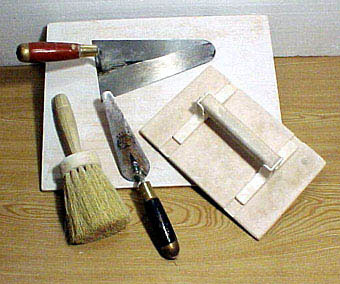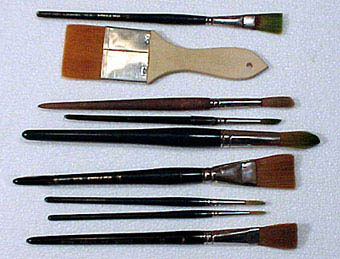 |
 |
|
|
|
Definitions
The term "fresco" comes from the italian word fresh, taken from the expression "dipingere a fresco" : painting on a fresh coating.
Fresco is a mural painting technique in fresh applied coating made of sand and lime. Pigment colours are simply diluted in clean water.
|
|
|
Several distinct layers comprise fresco :
- A first layer of rough coating. Applied on the support, this mortar is a mixture of hydrated lime (calcium hydroxide) and coarse sand.
- The second layer, the painting coat consists of hydrated lime and well-filtered fine sand.
- The third layer is the pictorial layer made of pigments and pure water applied in several coatings with a brush.
- The calcified layer results from the carbonation of the lime mortar which, while drying, produces a transparent protective crust (outer membrane that forms as a result of carbonation of lime). This pellicle includes the pigments and fixes them definitively.
|
The Byzantine technique
|

Archangel Mikael, Atelier Saint André
|
From time immemorial, Byzantine world valued the fresco technique. In the beginning of the XVIIIth century, at Mount Athos, the monk Denys of Fourna wrote a very complete treatise which describes the traditional oldest techniques.
One of the particular features of byzantine fresco is the tracing of the main lines of the drawing in the fresh mortar using a tip of wood or a bone. Moreover, the layer is smoothed before the colour application and not afterwards as in the modern techniques. This first smoothing makes the damp from the mortar rise up to the surface and the artist is compelled to work quickly. This process guarantees a greater clearness of the features and a better render of colors.
|
Materials |
|
|
|
| Formerly produced in small scale, lime is now available in 50 lb. bags at building material distributors or chemical suppliers. The lime must contain Ca(OH) 2 and less than 10% of clay. Lime for fresco is called "hydrated lime" in the USA as in Switzerland. In France it is called "extinct airy lime" (standard NF P 15510). Lime is often qualified as "fat" because of the consistency it gives to the mortars.
The lime bags must be well closed and preserved from humidity and moisture
Sand must be well selected : the best quality is extracted from rivers. Never use ocean sand because of the salt it contains (saltpetre), nor of ferruginous (iron-bearing) sand because of the red trails that might appear on the fresco. It must be clean and if you want to check its purity, you just have to plunge a pinch in a glass of water, stir, and observe the color of the water : if it gets muddy, it is better wash it and dry it before use for fresco.
According to the type of surface you wish for the fresco, you can choose large river sand or fine quartz sand. The choice of the sand is also determined by the size of the fresco : large sand is used for a large-size fresco and guarantees more solidity, while fine quartz sand allows for fine details of a small fresco. For external works, large sand is preferable.
In the U.S., construction sand is used for the coarse sand, and sterilized play sand for the fine sand, available at mason's supply distributors.
Water must be as pure as possible. Spring water is the best, but water from the tap is also appropriate if it is free of chlorine. Do not use stagnant or mineral-saturated water.
|
|
Carbonation
|
Hydrated lime mixed with water and sand toughens gradually in contact with the carbon dioxide of the air. This process reconstitutes to some extent the limestone of origin by forming a calcium carbonate crust that fixes the colors of the frescoes.
To explain this phenomenon by chemical symbols : hydrated lime Ca(OH)2 combined with carbon dioxide of the air (CO2 ) reforms calcium carbonate (CaCO3) according to the reaction:
Ca(OH)2 + CO2 produces CaCO3 + H2O
|
|
|
Tools
|
 |
Specific tools are required for fresco, including a shovel or hoe, wheelbarrow if necessary, and a basin for mixing mortar. In addition, the folowingtools are necessary:
- Stiff trowels (4" or 5", called a float) to mix and apply the mortars.
- Large nearly square floats (made from metal or other water-impervious material) for smoothing and other uses
- Stopper (a kind of large brush) to wet the support and to dampen the mortar.
- Cat's tongue trowel (small lengthand flexible trowel) to smooth the painting coat.
- Metal rule "to draw up" the rough coat. |
Brushes
|
 |
Choose cheap synthetic brushes because lime is caustic and burns them quickly. To prolong their lifespan, wash them with soap and water often. Provide yourself with broad brushes for great surfaces and to work quickly. |
|
|
|
|
|